You have a brilliant idea, the drive to succeed, and the passion to make a difference—but where do you start? The challenge of identifying a viable niche, understanding market demands, and creating a product that stands out can be daunting. You’re grappling with uncertainties about scaling, customer acquisition, and competition.
Contents:
In this article, we will uncover five compelling SaaS startup ideas that align with current industry trends and hold the potential for substantial growth and impact. So if you’re ready to turn your entrepreneurial dreams into reality, read on and discover the possibilities in the SaaS realm.
Observing SaaS Landscape
Software as a Service is a cloud-based software distribution model where you host apps on a remote server and make them available to users online. Users typically access SaaS applications through a web browser, without the need for installation or maintenance on local devices. An example of such a service is Google Workspace or Salesforce.
SaaS Market
The global SaaS market has expanded remarkably, with pre-pandemic growth accelerating during the COVID-19 pandemic as businesses sought scalable and remote-access solutions. Various reports estimate that the market will reach over $600 billion, reflecting a strong compound annual growth rate.
The market is highly competitive, with major players like Salesforce, Microsoft, Adobe, Google, and Oracle leading the way. However, niche ideas for SaaS startups have a high chance of winning the competition when catering to specific audiences or needs.
Future Outlook
The SaaS model is expected to expand further with advancements in technology such as artificial intelligence, machine learning, and automation. Emerging trends include industry-specific SaaS solutions, increased emphasis on security measures, and the incorporation of advanced analytics and customer engagement capabilities.
Challenges in the SaaS Industry
While the SaaS market is thriving, it faces several challenges:
- Intense Competition: The market is crowded with numerous players, making it challenging for new entrants to differentiate their offerings. Competing on features, price, and customer support can be difficult.
- Churn Management: High churn rates can significantly impact revenue. You need to invest in customer support and engagement strategies to keep users satisfied and reduce churn.
- Data Security and Compliance: Storing and processing sensitive customer data presents security risks. To become a well-known SaaS startup, you should ensure robust cybersecurity measures and comply with regulations (like GDPR, HIPAA, etc.), which can be complex and resource-intensive.
- Integration with Other Systems: Your clients most likely will use multiple software tools, so your SaaS applications need to integrate seamlessly with existing systems. Building and maintaining these integrations can be complex.
- Service Reliability and Downtime: Providing a reliable service is critical. Downtime can lead to customer dissatisfaction and loss of trust.
Top SaaS Startup Ideas
Now let’s see what are the top SaaS business ideas you can leverage for your future project.
Remote Team Collaboration Platform
The rise of remote work has created a significant demand for collaboration tools that enhance communication, project management, and productivity among distributed teams.
Features to include:
- Real-Time Messaging: Instant messaging and group chat functionalities to facilitate quick communication.
- Video Conferencing: High-quality video and audio conferencing capabilities to support virtual meetings.
- File Sharing and Storage: Secure cloud storage for easy file sharing and access to documents and resources.
- Task Management Tools: Features for task assignment, tracking progress, and setting deadlines to enhance project management
- Team Collaboration Boards: Kanban boards or similar tools for visualizing project pipelines and progress.
- Integration with Other Tools: API access and integration with popular applications like Google Workspace, Slack, Trello, etc.
- Time Tracking: Built-in tools for tracking time spent on tasks are useful for project billing and productivity analysis.
- User Analytics: Analytics dashboard to monitor the engagement and productivity metrics of team members.
- Customizable Workspaces: Options for teams to customize their workspace according to their needs and preferences.
Your target audience will be other small businesses that require budget-friendly, flexible solutions for remote collaboration. Also, remote teams in larger companies employing remote work policies often look to centralize their communication and project management. Potentially, your SaaS ideas can target individuals who work on multiple projects without a fixed location and need tools for managing client communications and project delivery.
Potential competitors:
- Slack: Known for its messaging capabilities and integrations.
- Microsoft Teams: Popular in corporate environments, offering a suite of collaboration tools.
- Zoom: Primarily for video conferencing but expanding into collaboration features.
- Trello: A task management tool that provides visual boards, which is popular among teams.
- Asana: Focuses on task and project management with collaboration features.
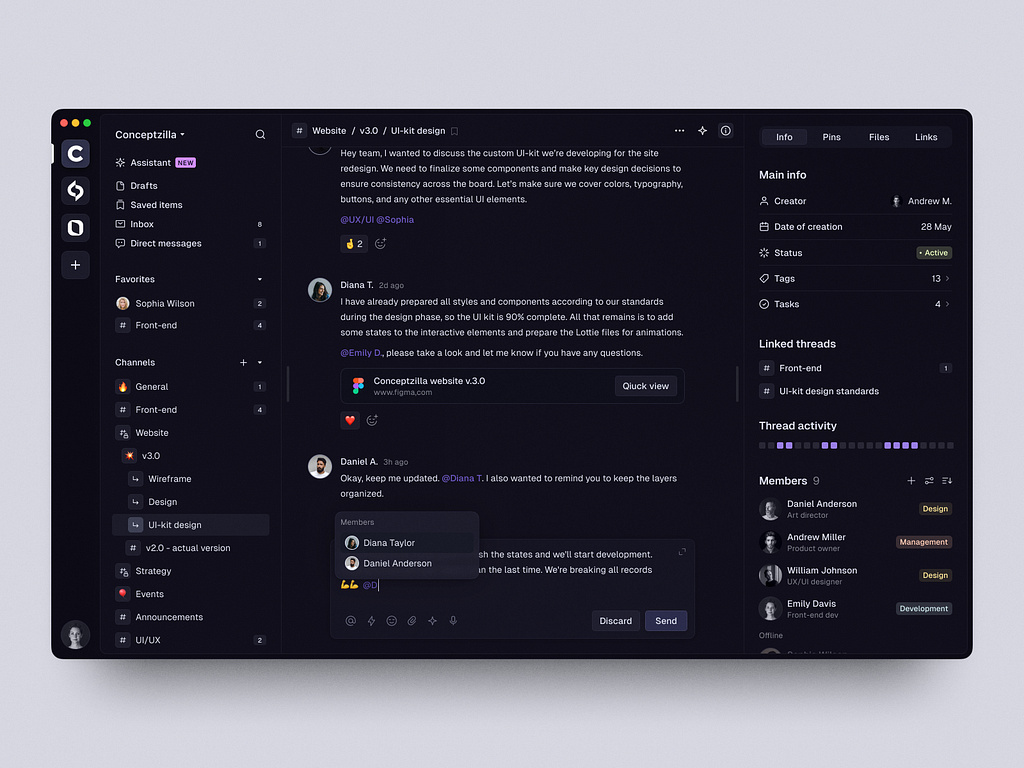
Team Communication SaaS Platform by Conceptzilla
Subscription Management Software
With the growing prevalence of subscription-based business models across various industries, there is a significant opportunity to develop SaaS startup ideas based on subscription management. It caters to companies managing recurring billing, customer retention, and subscription analytics.
Features to include:
- Automated Billing and Invoicing: Streamlined invoicing and billing processes with automated scheduling for recurring payments.
- Customer Portal: A user-friendly dashboard that allows customers to manage their subscriptions, payment methods, and billing history.
- Analytics and Reporting: Comprehensive analytics tools to track subscription metrics like churn rates, MRR (Monthly Recurring Revenue), and customer lifetime value.
- Payment Gateway Integrations: Support for various payment processors (e.g., Stripe, PayPal, Square) to facilitate smooth transactions.
- Cancelation and Retention Tools: Features to help reduce churn rates, such as reminders for renewal, discount offers, or easier cancelation processes.
- Customizable Subscription Plans: Ability for businesses to create flexible subscription models, such as tiered pricing or usage-based billing.
- Tax Compliance Management: Automatic tax calculations and invoicing in compliance with regional regulations.
- Multi-Currency Support: Functionality to handle transactions in multiple currencies for global businesses.
- API Access for Integration: Easy integration with existing CRM, ERP, or other business systems for seamless functionality.
- Notifications and Alerts: Automated alerts for upcoming renewals, payment failures, and other important events.
Businesses with subscription-based models requiring effective management of billing and customer relationships are your target audience. What’s more, with the hype of digital marketplaces, you can aim your SaaS ideas at online retailers offering subscription boxes or services that benefit from tailored subscription management tools. The same goes for streaming platforms, online magazines, fitness studios, and e-learning companies.
Potential competitors:
- Chargebee: Offers comprehensive subscription management and recurring billing processes.
- Recurly: Focuses on subscription billing, with strong analytics and integration capabilities.
- Stripe Billing: Provides billing solutions with advanced features for managing subscriptions through a developer-friendly platform.
- Zuora: Known for its extensive features in subscription economy management, catering primarily to large enterprises.
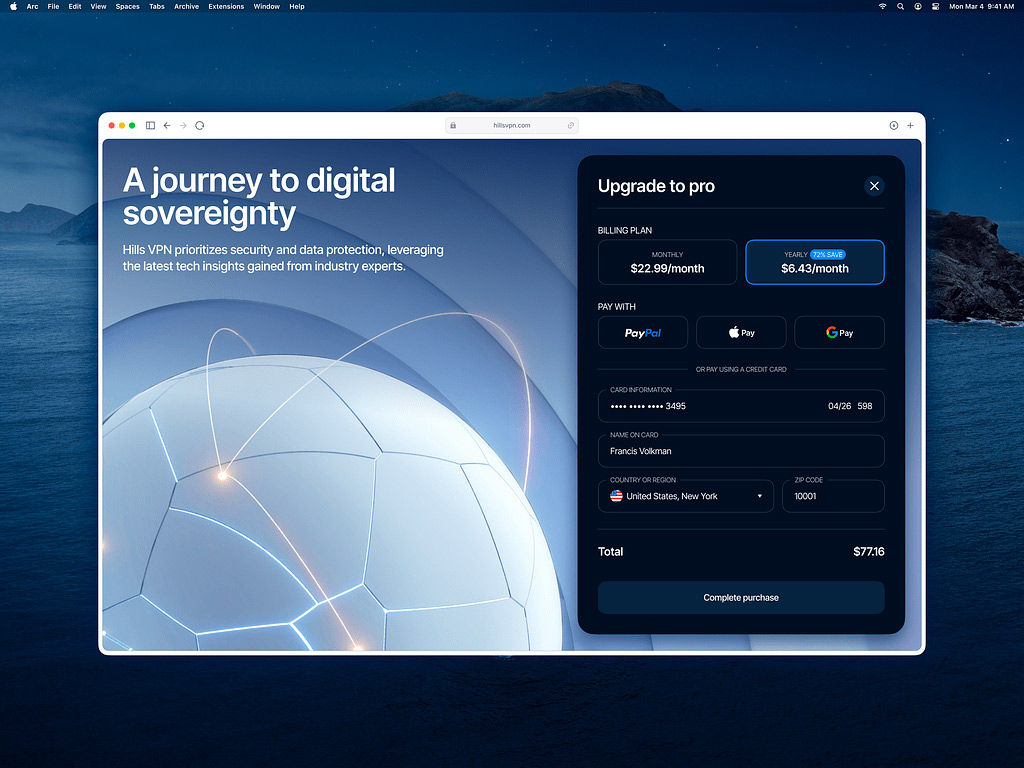
VPN Service Checkout Process by Shakuro
AI-Powered Customer Service Chatbots
This idea represents a growing trend in the SaaS industry. The chatbots leverage artificial intelligence to provide real-time customer assistance, streamlining communication, enhancing customer experiences, and taking the load off your team.
Features to include:
- Natural Language Processing (NLP): With this feature, the chatbots understand and interpret human language, providing accurate responses.
- Multi-Channel Support: Allows chatbots to be deployed across various platforms such as websites, social media, and messaging apps (like WhatsApp and Facebook Messenger).
- Contextual Understanding: They can follow conversational context and manage complex queries seamlessly.
- Integration Capabilities: Offer APIs to integrate with existing CRM systems, ticketing systems, and other business tools to streamline operations.
- Customization Options: Allow businesses to tailor the chatbot’s tone, personality, and responses to match their brand.
- Escalation Protocols: These include features that allow seamless escalation to human agents when complex issues arise, ensuring customer needs are met.
- Analytics and Reporting: Tracks performance metrics such as response times, customer satisfaction scores, and common inquiries to inform improvements.
During SaaS development, consider aiming your services at small to medium-sized enterprises (SMEs). They seek cost-effective solutions to enhance customer service without needing a large support team. Companies in the telecommunications, finance, and healthcare sectors can benefit from efficient customer interactions and support. Other software providers can integrate chatbots into their platforms to improve customer support within their ecosystems.
Potential competitors:
- Drift: Focused on conversational marketing, the company offers chatbots that assist with lead generation and customer engagement.
- Intercom: A customer messaging platform that provides chatbots for customer support and engagement.
- Zendesk Chat: Offers live chat and chatbot solutions integrated within its customer service platform.
- Freshchat: A messaging tool with AI-powered chatbots for customer support and engagement.
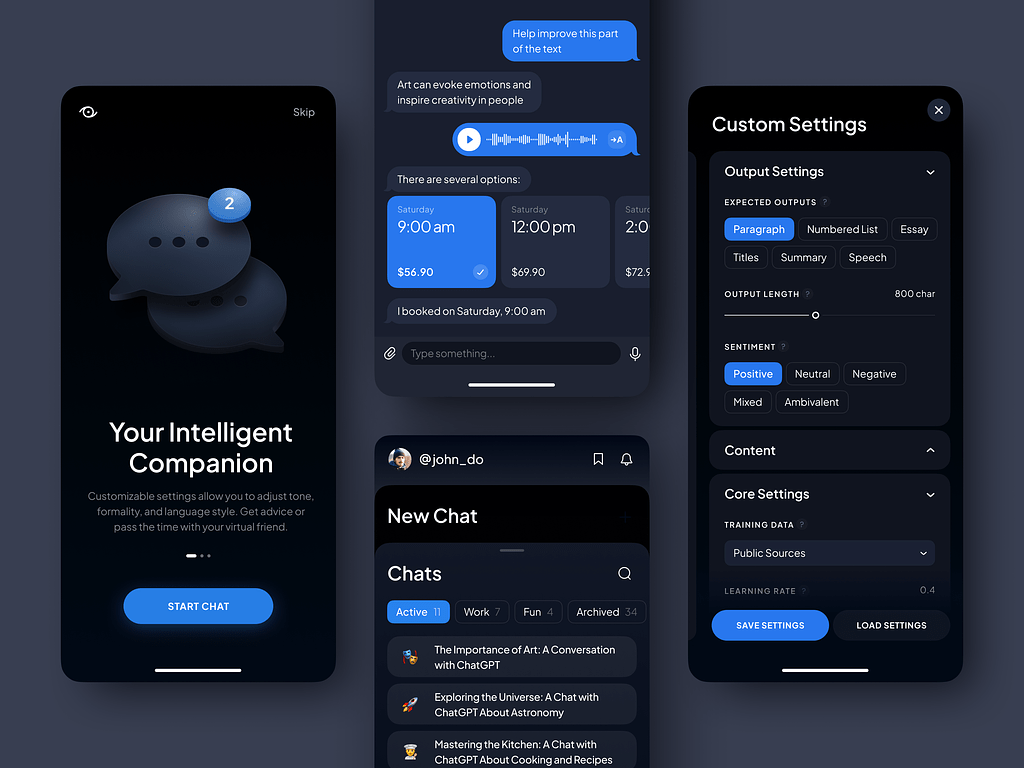
The AI Prompt Assistant by Conceptzilla
E-Learning and Course Management System
The e-learning market continues to grow rapidly, driven by technological advancements and the increasing demand for flexible learning options. A SaaS-based educational course management system (CMS) can provide educational institutions, corporations, and independent educators with the tools to create, manage, and deliver online lessons effectively.
Features to include:
- Course Creation Tools: Implement intuitive editors for creating courses with various media types (videos, quizzes, readings, etc.)
- User Management: Add features to manage users, groups, roles, and permissions for administrators and instructors.
- Assessment and Analytics: Automated grading will help teachers save time and find the weak spots of their students quickly.
- Interactive Learning: Support discussion boards, live sessions, webinars, and collaborative projects to enhance learner engagement.
- Integrations: Offer API capabilities to connect with third-party tools such as communication tools (like Zoom) and marketing platforms.
- Content Management System (CMS): Integrate a central repository for course materials, allowing easy updates and version control.
- Payment Processing: Consider integration with payment gateways for course purchases, subscriptions, and billing.
- Compliance and Certification: Add delivering certifications and tracking compliance training to meet regulatory standards.
For these SaaS startup ideas, the target market is wide. For example, educational institutions looking to offer online courses or enhance their existing curriculum with digital content. Around 90% of businesses now provide digital learning options for their employees, so they are also a great choice. Organizations focused on community education and training can benefit from cost-effective solutions to reach a broader audience. Don’t forget about freelancers and subject matter experts who want to create and sell their online courses.
Potential competitors:
- Moodle: An open-source learning platform that provides a CMS but may lack some modern SaaS features (like responsive design).
- Canvas: A popular LMS with robust course management and student engagement.
- Teachable: An easy-to-use platform for course creators to build and sell online courses, focusing heavily on monetization.
- Coursera for Business: Provides companies with access to a wide range of courses and learning paths from top universities and organizations.
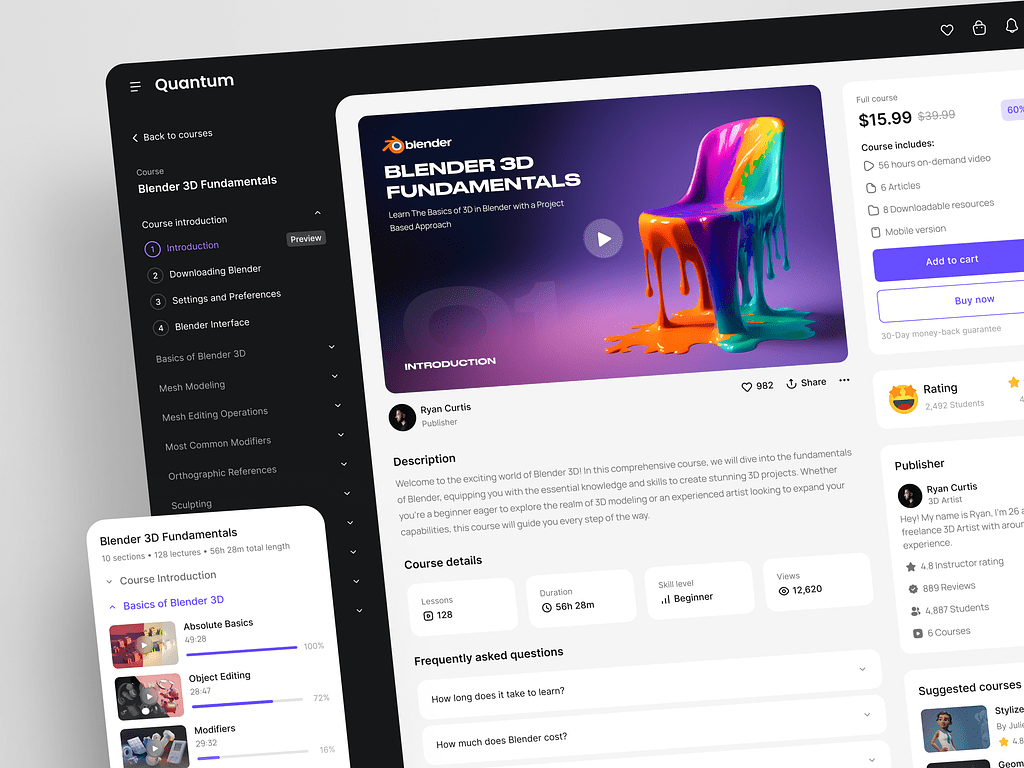
Online Education Web Platform by Conceptzilla
Inventory Management Solutions for SMEs
Inventory management is crucial for SMEs to optimize supply chain operations, reduce costs, and improve customer satisfaction. That’s why SaaS business ideas for inventory management solutions can provide an accessible and scalable way to manage inventory, track stock levels, and streamline operations.
Features to include:
- Real-time Inventory Tracking: Include automatic updates to inventory levels as sales and purchases occur, providing accurate stock data.
- Multi-Channel Integration: Add integration capabilities with various sales platforms (e.g., eBay, Amazon, Shopify) and POS systems to unify inventory management.
- Automated Reordering: Consider alerts and automated purchase order creation when stock levels drop below predefined thresholds.
- Inventory Valuation: Offer tools for inventory valuation methods (FIFO, LIFO, etc.) to help businesses maintain accurate financial records.
- Reporting and Analytics: Add comprehensive reporting features to analyze sales trends, turnover rates, and inventory costs, aiding in data-driven decision-making.
- Barcode Scanning: Support barcode scanning to facilitate faster check-in/check-out processes and accurate stock-taking.
- Supplier Management: Add features to manage supplier info, track performance, and streamline procurement processes.
- Stock Audits: Offer tools for conducting periodic stock audits and cycle counts to ensure inventory accuracy.
As the header suggests, aim at SMEs that need to track stock levels and manage sales efficiently. Small manufacturers also require inventory management for raw materials and finished goods. Alternatively, these ideas for SaaS startups can target online businesses requiring effective inventory tracking across multiple sales channels and warehouses.
Potential competitors:
- TradeGecko (QuickBooks Commerce): A cloud-based inventory management solution targeted at small and medium-sized businesses with multi-channel capabilities.
- Zoho Inventory: Part of the Zoho suite, it offers inventory tracking, order management, and integration with accounting software.
- Vend: A retail management solution with strong inventory features, tailored for retail SMEs and compatible with multiple payment systems.
- inFlow Inventory: A robust inventory management system designed for small businesses, emphasizing barcoding and reporting.
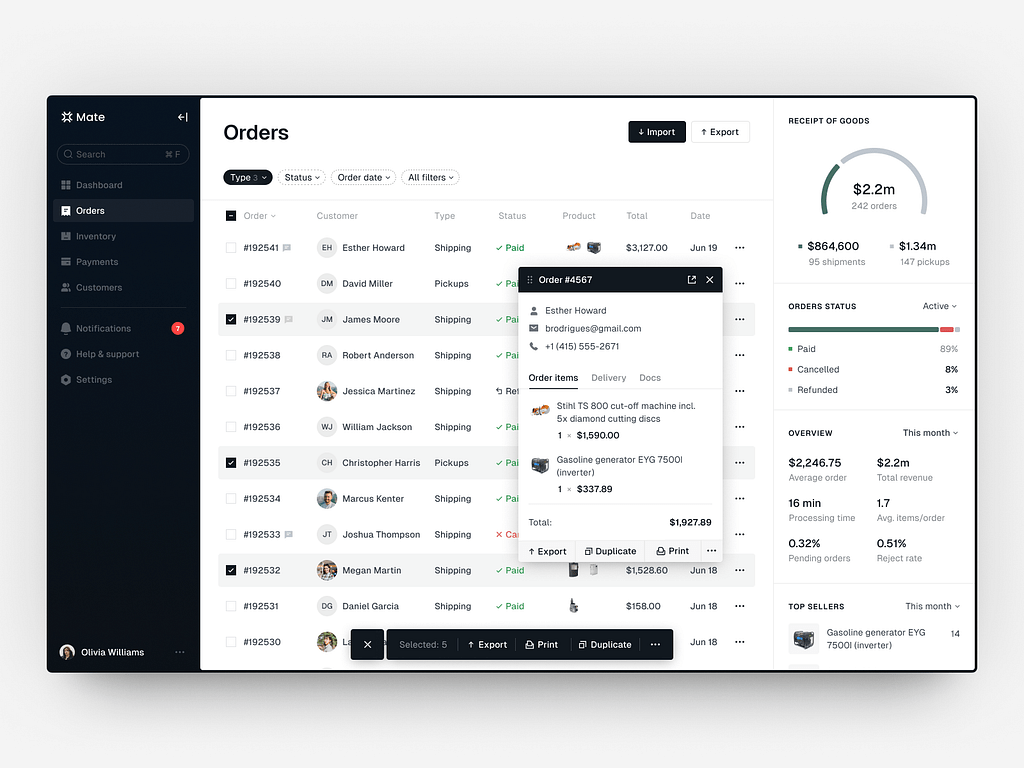
E-Commerce Admin Dashboard Design Concept by Shakuro
Social Media Management Tools
These tools are essential for businesses that want to streamline their social media presence, engage with their audience, and analyze their performance across various platforms. As a SaaS startup, creating a comprehensive solution can attract a wide range of users to your product.
Features to include:
- Post Scheduling and Automation: Enable users to schedule posts across multiple platforms in advance.
- Analytics and Reporting: Provide insights on engagement, reach, and follower growth to measure performance.
- Multi-platform Support: Add integration with major social media networks like Facebook, Twitter, Instagram, LinkedIn, etc.
- Social Listening Tools: Allow clients to monitor brand mentions, keywords, and industry trends to keep up with audience sentiment.
- Hashtag and SEO Suggestions: Help users enhance their posts for better visibility.
- Ad Management: Allow users to create, manage, and analyze social media ads from within the platform.
- Templates and Design Tools: Provide users with templates for consistent branding and design.
SMEs often do not have the resources for a dedicated social media team, so they will gladly harness your platform. Also, agencies that manage social media for multiple clients can benefit from your tool. Influencers and content creators want to strengthen their online presence.
Potential competitors:
- Hootsuite: One of the leading social media management tools with robust features and analytics.
- Buffer: Known for its simplicity in scheduling posts and analytics.
- Sprout Social: Offers advanced analytics and customer relationship management features.
- Later: Specializes in visual planning for Instagram but has expanded to other platforms.
- SocialBee: Focuses on content categorization and recycling to keep the feed active.
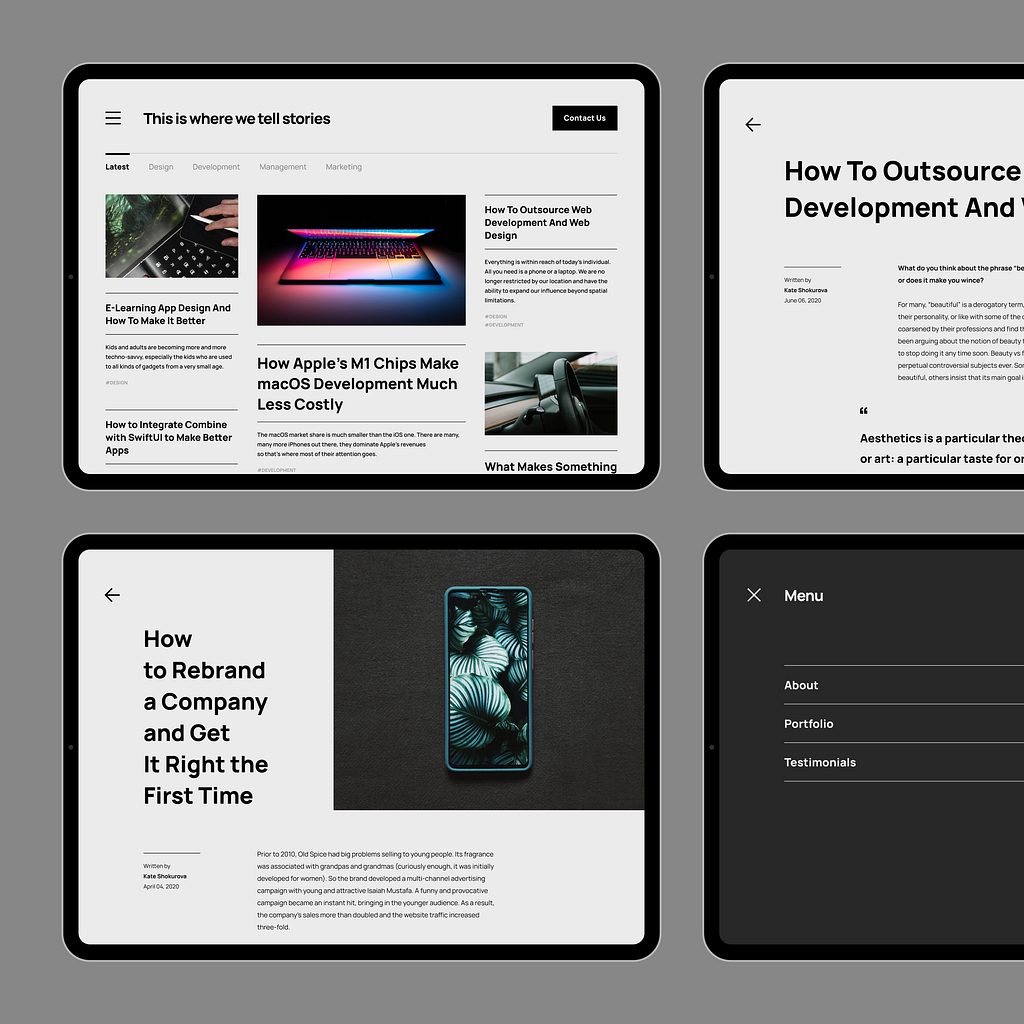
Web Platform for Content Creators by Conceptzilla
Health and Wellness Tracking Platforms
As health and wellness awareness grows, there is an increasing demand for effective platforms that help people track their health metrics, wellness activities, and fitness goals. SaaS ideas focused on health and wellness tracking can provide users with valuable insights, personalized recommendations, and community support to enhance their overall well-being.
Features to include:
- Activity Tracking: Add a comprehensive system to log daily physical activities, including workouts, steps, and exercises.
- Nutrition Tracking: Implement tools for tracking food intake, caloric values, macronutrients, and hydration, with the ability to create meal plans.
- Health Metrics Monitoring: Consider features to log and analyze health metrics such as weight, BMI, blood pressure, glucose levels, and sleep patterns.
- Goal Setting and Tracking: There should be a feature to set personal health and wellness goals, with progress tracking towards these objectives.
- Wearable Device Integration: Integration with popular fitness wearables and health devices (e.g., Fitbit, Apple Watch) for seamless data collection.
- Personalized Recommendations: AI-driven insights and suggestions based on user data to improve health outcomes and encourage positive habits.
- Community Support: Forums or groups where users can interact, share experiences, and motivate each other in their wellness journeys.
- Health Assessments and Quizzes: Tools for users to assess their health status and receive feedback tailored to their individual needs.
- Telehealth Feature: Options for virtual consultations with healthcare professionals to address individual health concerns.
- Progress Reporting: Regular reports that summarise user achievements, challenges, and areas of improvement to facilitate accountability.
- Reminder Notifications: Alerts and reminders for medication, hydration, workouts, and meal times to promote adherence.
Aim your SaaS business ideas at health-conscious individuals looking to manage fitness goals. People managing chronic conditions who need to track lifestyle factors, medication adherence, and health metrics are also a good fit. Moreover, you can target clinics and wellness centers that want to monitor patient health outside of traditional healthcare settings.
Potential competitors:
- MyFitnessPal: A widely used app for tracking diet and exercise, offering features for calorie counting and community support.
- Lose It!: A mobile app focused on weight loss through food tracking and goal setting.
- Fitbit: Known for its wearables, Fitbit provides a comprehensive app that tracks activity, sleep, and nutrition.
- Noom: An app integrating psychology with weight loss and wellness tracking to promote healthier habits.
- Apple Health: A platform providing users with health-tracking capabilities through integration with various health apps and devices.
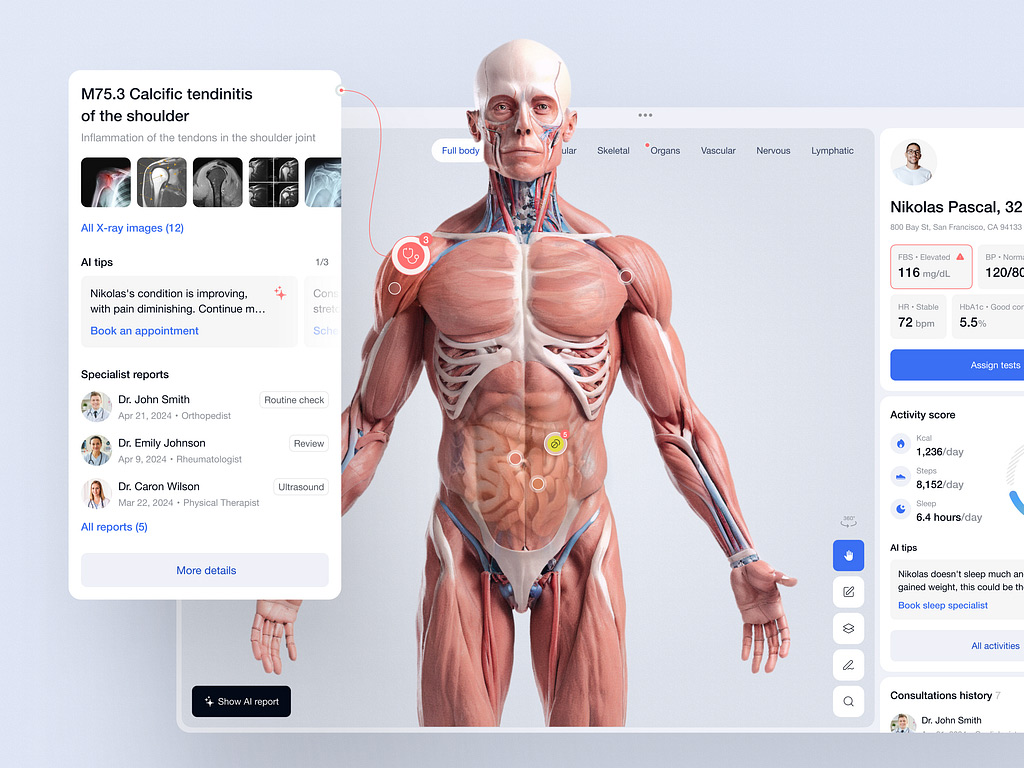
Doctor’s Dashboard Design Concept by Shakuro
Virtual Event Management Software
With the rise of remote work and digital connectivity, online events have become essential for businesses to engage audiences. SaaS startup ideas focused on virtual event management software can provide tools that facilitate planning, execution, and post-event analysis of online events, ranging from webinars and workshops to conferences and trade shows.
Features to include:
- Event Registration and Ticketing: Simplified registration processes, ticketing options (free/paid), and customizable landing pages are a must-have.
- Customizable Events: Add options for branding the virtual environment, including logos, colors, and themes to reflect the event’s identity.
- Livestreaming Capabilities: Allow high-quality video and audio streaming for live sessions, with support for multiple presenters and guest speakers.
- Interactive Networking Features: Consider tools for attendees to engage with each other through chat, video calls, and virtual booths.
- Engagement Tools: Offer polls, Q&A sessions, quizzes, and feedback forms to enhance audience participation.
- Content Management: Provide easy uploading and storing of event material, including presentations, documents, and recordings for attendees.
- Analytics and Reporting: Add comprehensive metrics on attendance, engagement, and feedback to evaluate event success and inform future planning.
- Integration Capabilities: Allow clients to connect with CRM, email marketing, and social media platforms for streamlined outreach and engagement.
Your target audience will be corporate organizations looking to host training sessions, product launches, and internal meetings virtually. Schools, universities, and training providers aiming to conduct remote learning events or workshops will also harness your platform.
Potential competitors:
- Zoom: A leading video conferencing tool that offers webinar solutions and virtual meeting capabilities for various events.
- Hopin: A platform designed specifically for virtual events, providing functionalities for networking, sessions, and exhibitor spaces.
- Webex Events: A comprehensive platform for hosting large-scale virtual events with integrated registration and engagement tools.
- Eventbrite: Known primarily for ticketing, Eventbrite has expanded features to support virtual and hybrid event management.
- Microsoft Teams: Offers capabilities for hosting events alongside collaboration tools for businesses, with integrations available.
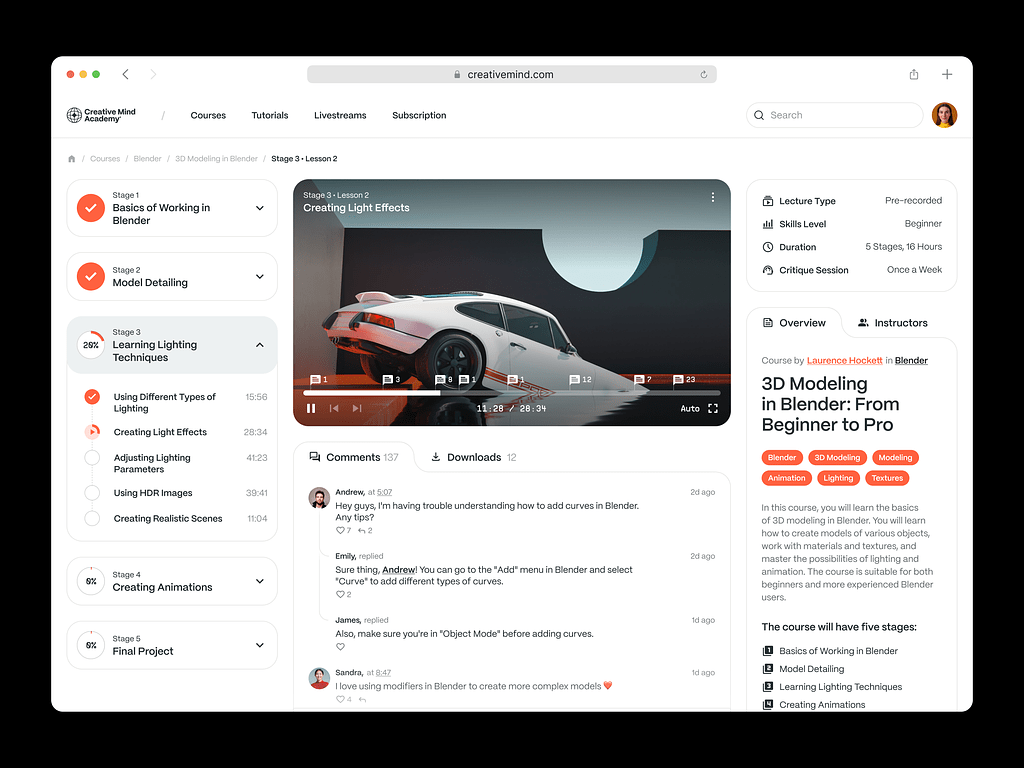
Online Courses Platform Website by Shakuro
Financial Planning and Analysis Tool
In an increasingly complex financial landscape, companies seek reliable tools for efficient financial planning, budgeting, forecasting, and performance analysis. These SaaS ideas focused on financial planning and analysis can provide businesses with essential tools that enhance decision-making and improve financial health.
Features to include:
- Budgeting and Forecasting Tools: Add options for creating budgets and forecasting financial performance.
- Scenario Analysis: Offer tools for modeling different financial scenarios and analyzing the impact of various assumptions on business outcomes.
- Dashboards and Reporting: Clients should be able to customize dashboards, visualize key performance indicators (KPIs), and generate insightful reports.
- Collaboration Features: Facilitate collaboration among stakeholders, enabling real-time editing and comments on financial models.
- Data Integration: Allow integration with existing ERP, CRM, and accounting systems for seamless data flow and accuracy.
- Variance Analysis: Analyze deviations between planned and actual financial performance, helping to identify diverse impacts.
- Compliance and Audit Trails: Ensure compliance with financial regulations and maintain audit trails for transparency.
- Support for Multi-Currency and Consolidation: Add tools to handle transactions in multiple currencies and consolidate financial reports for multinational organizations.
Aim your SaaS business ideas at companies requiring accessible financial tools to manage their budgets and forecasts without the resources to hire dedicated financial teams. This includes other startups looking for effective financial models and projections to attract investors and manage their limited resources. If your solution offers to handle complex budgeting scenarios, then you can also take into account banks and investment firms.
Potential competitors:
- Anaplan: A leading FP&A platform that offers a cloud-based solution for budget planning, forecasting, and performance management.
- Adaptive Insights (Workday): A robust financial planning tool that provides capabilities for budgeting, forecasting, and reporting.
- Planful: Formerly known as Host Analytics, it offers FP&A solutions focusing on budgeting, forecasting, and reporting.
- NetSuite: Known for its ERP solutions, it includes budgeting and forecasting features within its financial management module.
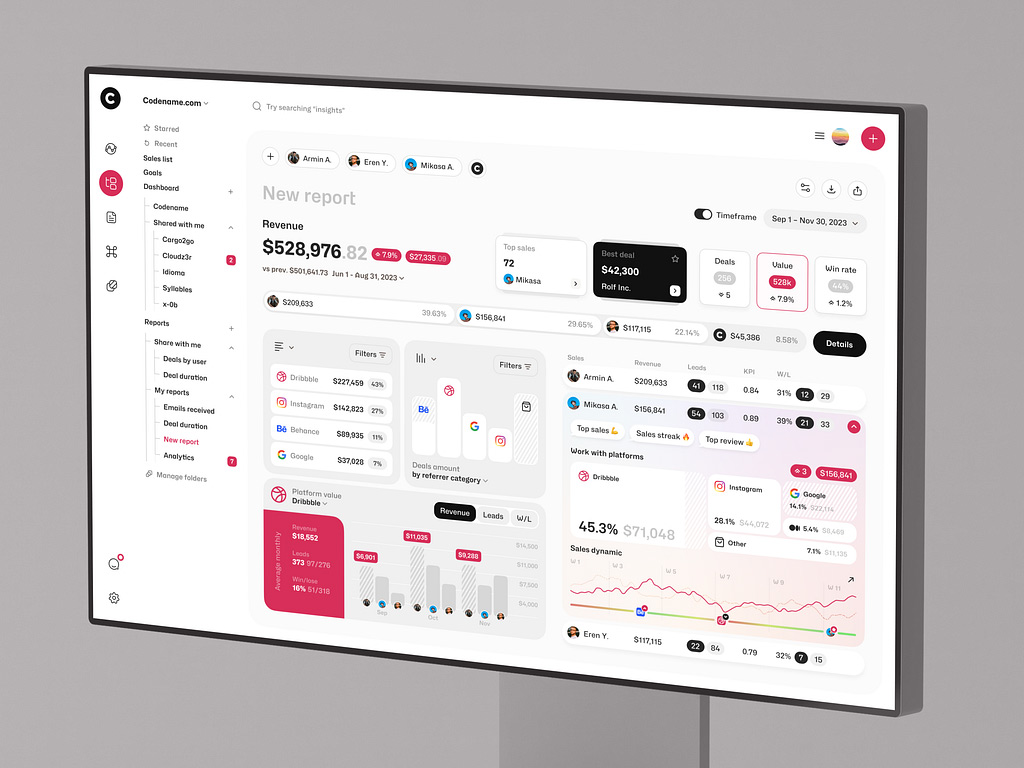
Sales Analytics Dashboard by Shakuro
Conclusion
As you dive into SaaS development, consider the ideas we’ve discussed, and let your creativity and passion guide you. Stay attuned to market trends, conduct thorough research, and adapt your strategy based on user feedback. Remember, the key to success lies in continuous learning, flexibility, and the willingness to innovate.
Do you need a development team to bring your future SaaS ideas to market? Contact us and let’s work together to build a versatile product.

